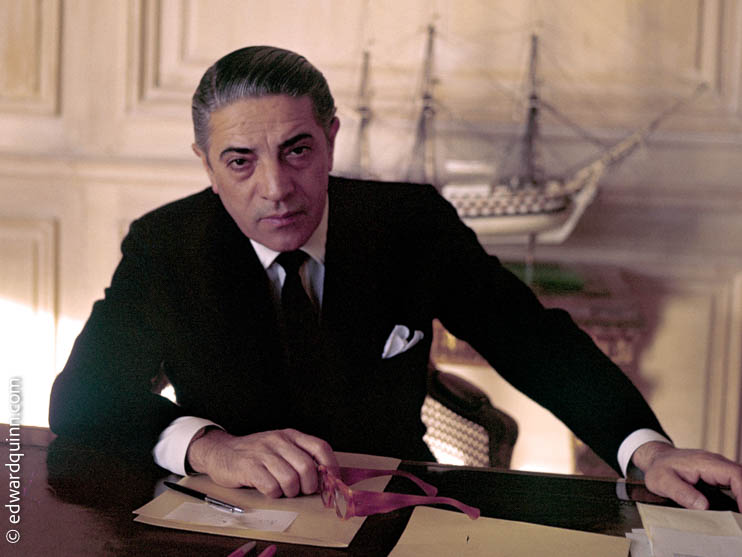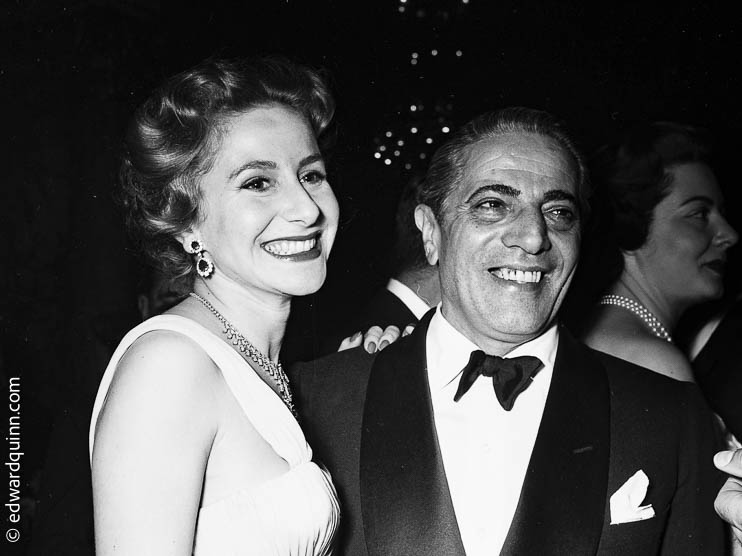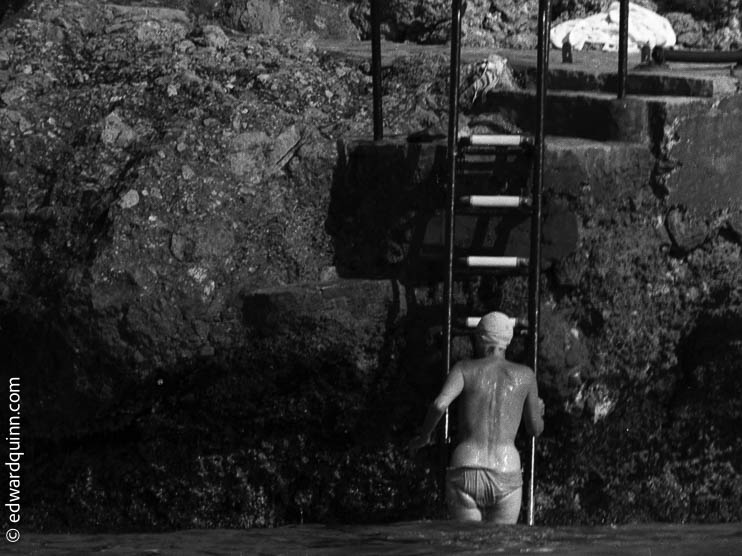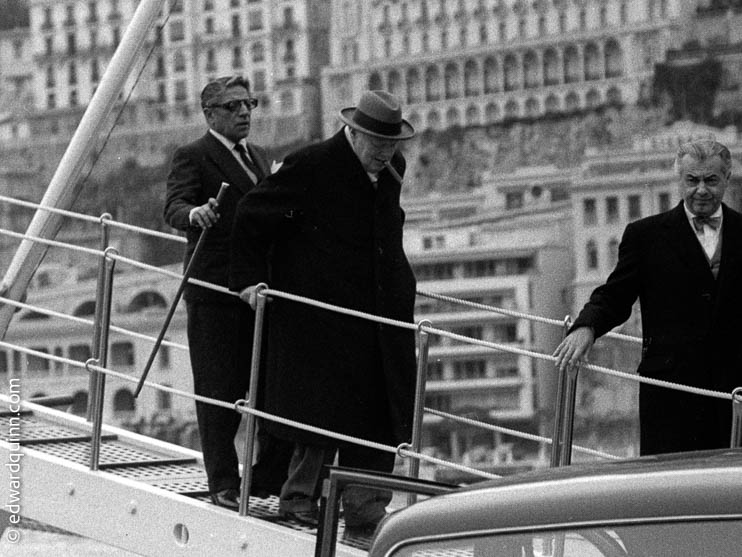Aristotle Onassis
By Edward Quinn
The Onassis story began for me the day I was asked by TIME magazine to get a photograph of a Greek who was buying large numbers of shares in the Monte Carlo Casino. I found out that this man – Aristotle Onasssis – was the owner of a whaling ship which had just anchored in Nice harbour. I went there and photographed a man on the deck answering the description given to me and then was told that he was not Onassis, but one of his Greek associates. He told me that Onassis was living at the Chateau de la Croë at Cap d'Antibes.

The imposing château stood in the middle of a beautiful park of pine trees, just beside the sea. It had once been the famous honeymoon refuge for the Duke of Windsor and his bride Wallis Simpson, after the King had abdicated from the Throne of England. A white coated Maître d'hôtel opened the door for me and Onassis came out almost immediately. He smiled when I explained why I had come, but he said that he had no intention to let me or anybody else take photos of him. "I'm not a film star, I don't want my pictures in the papers," he said. Nevertheless, he showed me his photo album and told me to take any pictures I liked from it.
In most of these photos a proud Mr. Onassis was standing in front of whaling ships or oil tankers with bottles of champagne as he christened his new ships. But I said: "I am sorry, Mr. Onassis, as I'm a photographer, I prefer to take my own photographs." Onassis shrugged his shoulders and took his album back and I went off disappointed.
It just happened that on the same day I was invited with some other journalists to have a drink in Spyros Skouras room at the Hotel Negresco in Nice. Skouras was then head of the 20th Century Fox film company, and a French inventor, Professor Chretien, had just sold them his latest invention, the wide-screen Cinemascope lens. While talking to Skouras I mentioned my meeting with his compatriot. Just at that moment the telephone rang and Skouras answered. He looked at me and laughed. I heard him say: “Why don't you come up." A few minutes later Onassis walked into the room and of course looked surprised when he saw me.
Skouras, who was in high spirits, said to Onassis: "You haven't been too cooperative with our friend from the press. Come on Ari, let's have a photograph together." Onassis laughed and reluctantly sat down beside Skouras who cleared all the drinks away (so as not to upset the American teetotalers league) and I was able to get my first picture of Onassis for the press. I think this was the first photograph to put Onassis in the public eye and it was of importance to me professionally, as from then on I had a good contact with Onassis who afterwards decided he needed the press.

I was able to get many exclusive pictures of him with his wife Tina and their children Alexander and Christina in the Château de la Croë and on the yacht "Christina" (named after his daughter).
Tina Onassis was the daughter of Stavros Livanos, a Greek shipowner millionaire, as important as Onassis. Tina had been educated in England and the United States and I was always on very good terms with her. I was even able to give her back confidence in her physical appearance. Tina had been injured in a car crash on an icy road in Switzerland; there had been rumours that she might be disfigured. When she came out of hospital, she let me take the first photos of her after her accident. To Tina's relief the pictures confirmed that she still looked attractive and her scars were not visible. She obviously had had some facial surgery, because her nose and features were changed after the accident.
During an interview Tina told me that she had seen Onassis for the first time when he came to discuss business with her father, but she did not take much notice of him. Onassis afterwards made spectacular efforts to impress her. Once at Oyster Bay, Long Island, he raced past Tina in a speedboat, with a banner streaming behind with the letters "T.I.L.Y." (meaning Tina I love you). Onassis also gave her a gold bracelet with a golden coin which had the inscription "Saturday, 7 p.m. 17 April 1943, T.I.L.Y." When she asked what the inscription meant, Onassis said shyly: "It was the day I fell in love with you." Tina was then only 14 years old.

Even though Aristotle Onassis was small - 5 feet and a few inches - he looked virile and women were attracted by him. Many of them even said that he was the most charming man they knew. Certainly, the way Onassis lived surrounded by luxury had an effect on people, but this was not the only reason why people liked him. Onassis had his special charm – a charisma, and women appreciated that he was intensely interested and attentive and he gave each one the impression that he considered her unique.
It was during a cruise on the "Christina" that a mysterious friendship developed between Aristotle Onassis and the fiery temperamental diva Maria Callas. She and her husband and impresario Giovanni Meneghini, an Italian millionaire, had been invited with Sir Winston and Lady Churchill and some other guests on a three-week cruise through the Gulf of Corinth.
Soon after the "Christina" left Monaco, it ran into very bad weather. Most of the guests on board were seasick and had to stay in their cabins. The only exceptions were La Callas and Onassis who found themselves alone for many hours, especially at night. This gave them every opportunity to get to know each other better. When the boat got to Istanbul the couple went ashore together. On her return on board Maria told her husband that she was in love with Onassis,
Onassis was able to entice "La Divine" Greta Garbo out of her solitude. Garbo never seemed to refuse an invitation from him. She became a regular visitor to the Riviera and also went on cruises with Onassis to Saudi Arabia. Onassis was also involved when Garbo bought at a cost of 20 million old francs a 6-roomed villa "The Rock" beside the sea at Cap d'Ail, just outside Monaco.
As the press was always interested in Garbo, I photographed her whenever I could. Every time I saw her, I would politely ask her to pose and I explained that this would be so much better than photos taken in a scuffle while she was turning away to hide her face. But Garbo's only reply would be: "No, I want to be alone".
At her villa "The Rock" Garbo preferred to swim in the sea even though the villa had a swimming pool. From a spot high up on the road she could be seen when she walked down a small path to the sea. At first, she wore knee length white shorts even for swimming. Then one day her rare neighbors saw somebody going down to the sea in a rather skimpy azur bikini. Could this possibly be the great Garbo, star of "Queen Christina" and "Camille"? To find out I decided to go around to her bathing place with a fisherman who brought me over from Monaco very early one morning in his small boat. When we got near the villa, we did not have to wait long, before Garbo came down over the rocks, followed by her friend and guardian angel George Schlee. I saw them looking suspiciously at the boat, but they could obviously only see the unperturbed fisherman with his rod. Garbo seemed to be reassured so she energetically did some Swedish exercises. "La Divine" was very sprightly and her figure was as svelte as ever.
After her gymnastics Garbo dived into the sea and swam around, alternating a very good crawl and backstroke. I had heard that in New York Garbo lived like recluse, on the Riviera she seemed very relaxed and obviously enjoyed the sea and the sun, she even threw all caution to the wind and took off her bikini top as she swam around, ignoring the fisherman and unaware of me and my camera.

Onassis sometimes convinced Garbo to appear in public with him. They often had dinner together on the open terrace of the Hotel de Paris and once, to the amazement of all the guests, Garbo appeared with Onassis for a gala dinner at the Summer Sporting Club in Monte-Carlo. It was obvious that Garbo liked Onassis' company, he seemed to enchant her and during that evening she took off her dark glasses and even smiled – that famous "Ninotchka" smile - and I saw that she still had the same charm which had enchanted millions of film fans.
Everything on the "Christina" was absolutely top class. The boat - a Canadian frigate - had been redesigned by the famous Hamburg architect and designer Cäsar Pinnau and was stripped down and rebuilt at the Howaldtswerke shipyard and converted into a luxury yacht. Onassis demanded that every known gadget and the latest air conditioning and electronic equipment should be fitted. A cinema, a hospital ward and a complete operating room with an X-ray installation were also built in.
Onassis himself had a superbly furnished three-roomed suite on the "Christina". Above his Louis XV bureau he had an El Greco painting "Madonna and Angel" and beside it two golden swords given to him by Ibn Saoud. His bathroom had a kidney shaped, sunken bath of Siena marble with a mosaic copied from the Palace of Minos at Knossos. In all the bathrooms the gold taps were shaped like dolphins. There were fine guest suites, each named after a Greek island, and each one decorated by a different artist. The cabin named "Chios" was reserved for Sir Winston Churchill, a night reading light had been especially installed for him above the bed. All the cabins had telephones for 24-hour room service and each had extensions for even transatlantic calls.
The swimming pool on the aft deck was Onassis's showpiece. It was inlaid with a mosaic, representing a scene from Greek mythology, "The Bull of Minos", a copy of the floor of the Palace of Minos at Knossos. At the touch of a button it could be lowered to 2.5 m deep and then filled up with warm seawater. When raised it became a dance floor of 15 square meters. It could also be used as a lounge an Onassis once surprised Winston Churchill by lowering the floor while he was sitting there. Churchill afterwards enjoyed the joke, but at first he thought he might get an unwanted shower bath.
The Louis XV dining room had four murals called "Quatre Saisons" by the French artist Marcel Vertés. The games room had a large fireplace of lapislazuli, Onassis' favourite stone, and in a corner stood a grand piano. Amongst the paintings in the library and games room were portraits of Tina and her children Christina and Alexander. When Winston Churchill gave Onassis one of his paintings, "A view of the park in Chartwell", Sir Winston's home, this painting got the "place d'honneur" in the reception room.
A cosy separate bar had every possible kind of aperitifs and liqueurs. The high bar stools were covered with white whaleskin and whenever Onassis saw a female guest sitting on one, his great joke was to remark: "I hope you don't mind, but you happen to be sitting on a giant whale's private parts."

Onassis not only became a celebrity himself, he also wanted to attract other celebrities. He would often invite famous personalities on board the "Christina" and to the Monte Carlo gala dinners. He favoured Hollywood stars as guests, these included of course Greta Garbo and also Cary Grant, Marlene Dietrich, Frank Sinatra, Ava Gardner, Cary Cooper, Merle Oberon, John Wayne or Sammy Davies jun. Onassis liked to have a cosmopolitan group of guests, so when he gave a party, he would also invite some royalty. This could be the pretty Princess Marie-Gabrielle of Savoy, her sister Maria Pia with her husband Prince Alexander of Yugoslavia, the Maharanee of Baroda, the Rainiers, the ex King Peter of Yugoslavia and his wife, Prince Aly Khan... and of course, some important people from the shipping and oil business would also be present.
Onassis not only wanted publicity, but he also was able to use it to his advantage. Although he gave the impression of being generous and magnanimous, he preferred taking to giving. Some people thought that he only became involved with the dazzling world of the international set so that he could beguile the dull business tycoons. The publicity he got from being associated with famous people certainly helped him to advance his business projects. Once Onassis had made an interesting business contact, he would use all his assets, his luxurious boat and his famous friends and then with his chicanery and persuasive charm he would negotiate and conclude intricate business agreements.
I was often on the "Christina" when Onassis gave one of these lavish parties, they were certainly unforgettable. I was one of the rare photographers allowed on board and I could freely take photograph. We had a kind of a gentlemen's agreement. Onassis and Tina had a certain respect for me and my work, they saw the photographs appearing in magazines and never objected to any of the pictures.
The evening on board began with cocktails served by the side of the swimming pool and in the games room. Onassis did not like fancy drinks, he preferred his Greek favourites Ouzo and Mezés. Onassis certainly had the art of making everyone feel welcome. Even when his yacht was crowded, he would find a moment for everyone and he moved around amongst his guests, paying just as much attention to the pretty mistress of a businessman as he would to a rich industrialist with whom he was negotiating a deal. He could even be diplomat enough to talk to his archrival and brother-in-law Niarchos.

Onassis's wife Tina was the central figure of these brilliant receptions. But she got finally tired of her husband's hunger for publicity and the perpetual high life which had become an essential part of his life. The liaison of Onassis and Maria Callas and some other romantic relationship finally decided Tina that she had enough, so she got a divorce. Explaining the break-up of their marriage, she said: "I always liked simple things, but Ari began to prefer extravagance. He was a marvellous person but after he took over in Monte Carlo, his high society success spoilt him and ruined out life together."
When he met Winston Churchill, Onassis knew that this was the most important meeting of his life – the ultimate. The two men met through Churchill's son Randolph, a friend of Onassis. Sir Winston accepted an invitation to lunch with Onassis in Monte Carlo and at once they liked each other. A friendship began on that day which lasted until Churchill died.
It was a strange relationship: a famous English statesman and a Greek millionaire shipowner, what could they have in common? For the two men concerned, it was very simple, they just enjoyed each other's company and they did not see any necessity to go into any complicated explanations. Churchill certainly appreciated not only Onassis's hospitality, but also his dynamism and his competence to settle any problems and to take care of all of Churchill's needs without worrying him. Sir Winston who had lived a long complicated political life, just wanted to enjoy his holiday in the sun.
But for Onassis this friendship had other dimensions. He admired Churchill who represented for him the quintessence of the anglo-saxon and of course he had great esteem for Churchill's courage as a leader and politician. After their first meeting Onassis was elated and said that he and Churchill had not only discussed politics but life, philosophy and mankind in general. There were many more occasions when the two men spent long hours together on board the "Christina". Onassis even learnt to play the card game bezique so that he could be the partner of Sir Winston.

Sir Winston liked to have his dinner punctually at 8.15. After dinner there would often be a film show on board especially for old "Winnie". Although Onassis never called Sir Winston "Winnie", Churchill did use the friendly "Ari" when talking to Onassis. In the evenings after they had sipped a couple of Courvoisier cognacs, Onassis would squat down on the floor beside Churchill and sing. He had a good voice and went through all the old war-time songs he knew and even sang some light opera. Amongst his favourites were "It's a long, long way to Tipperary" and "Take a pair of sparkling eyes".
Onassis was so preoccupied with Churchill's well-being that once when he was expected on the "Christina", Onassis lay down on the bed in Sir Winston's cabin and then got the chief engineer to run the engines at different speeds in order to find the cruising speed which made the least vibrations.
Churchill always brought his budgerigar "Toby" with him to the Riviera. One day the pesty parakeet decided to enjoy some Mediterranean air and flew off. Churchill was so dejected that Onassis organized a day and night search not only in Monte Carlo but all along the coast. The police and the fire brigade were mobilized and Onassis nearly went beserk and did not even go to bed while commanding the search operations. Luckily the parrot got tired and was found 20 kilometers away near Nice.
